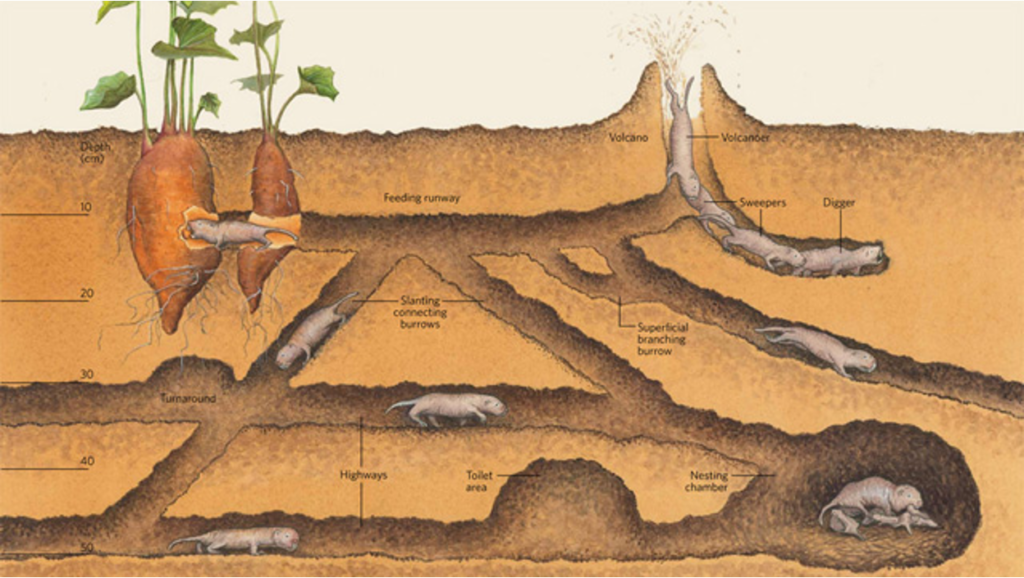by Colleen Steward
Imagine that you are on a trip exploring the Atlanta Zoo. You round the corner from the orangutan exhibit and find yourself face to face with an exposed labyrinth of underground tunnels revealed by a layer of plexiglass. As you look closer, you see small creatures scampering back and forth, darting from tunnel to tunnel in what looks like an orchestrated dance. Hairless. Wrinkled. Blind. You wonder what these strange little fellows could possibly be. Above you, a sign identifies your new furless friends as naked mole rats.

Naked mole rats, also adorably called sand puppies, are a unique species of rodent naturally found in eastern Africa. They live beneath the surface in a complex network of tunnels. Imagine creating a maze of underground tunnels up to 2.5 miles long, all without being able to see! The Smithsonian National Zoo maintains two live cameras of their naked mole rat colony (each of which has a queen!), and you can watch them run through the tunnels here.

Naked mole rats are also the only cold-blooded mammal and move their large front teeth independently, like chopsticks. These furless wonders are fascinating based on appearance alone, yet they have also been astonishing scientists for decades. Naked mole rats can live into their late thirties and are highly resistant to cancer, unlike other rodents of a similar size, including mice that have a maximum lifespan of only 4 years.
The secret to naked mole rats’ age-defying biology and resistance to cancer is a mystery that scientists are trying to solve. The first cancer resistance mechanism in naked mole rats was identified in 2009 and coined “early contact inhibition”. When cells are grown in a dish, they can be very picky about when to divide and multiply. Oftentimes, if there are a lot of other cells around it, the cell will refuse to divide. This is called contact inhibition–when a cell makes the decision to inhibit division because it is in contact with too many other cells. Since cancer develops from uncontrolled cell division, contact inhibition is an effective way to prevent cancer by avoiding rapid, abnormal growth. In naked mole rats, contact inhibition is initiated at a lower cell density compared to mice, as you can see in the image below.

While this was an important discovery, there is much more to the story. Over the years, several other properties of naked mole rat cells were found to contribute to cancer prevention, including the production of a structural protein called high-molecular-mass hyaluronan that has roles in reducing cancer spread. Then, in a 2020 study, researchers were surprised to find that something about the environment inside naked mole rats also helps prevent cancer.
One area of interest is the immune system. The immune system is a collection of cells that work together to fight off foreign invaders, including cancer. In naked mole rats, the ratio of certain immune cell populations is different from mice and humans. For instance, naked mole rats have a larger population of myeloid cells (cells derived from the bone marrow) and fewer lymphoid cells (cells related to the lymphatic system; T cells and B cells). Additionally, since naked mole rats completely lack natural killer cells (awesome name, right!) that usually act as a first line of immune defense, they rely on different early-responding cells called neutrophils to help control infections. Neutrophils come from myeloid cells, which are abundant in naked mole rats. Researchers are currently investigating how these differences influence aging and cancer prevention.

In addition to the immune system, a recent 2022 study highlighted epigenetic regulation, which uses markers to open and close sections of DNA, as another mechanism to control aging and cancer progression. Interestingly, scientists found that the queen of the colony aged more slowly than other naked mole rats due to changes in the epigenetic markers on her DNA. More perks of being the queen!
When we think about the curious mystery of the age-defying, cancer-eluding naked mole rats, it’s important to remember that there is likely not one gene, one pathway, or one simple answer that can cure cancer. Biology is exquisitely complex and the various systems and cells of our body are beautifully intertwined. Multiple changes and unique interactions work together to prevent naked mole rats from developing cancer. By better understanding these changes, researchers can learn about human cancer and guide the development of improved cancer treatments.
Marvels of biology, naked mole rats are fun to watch cruise through tunnels in zoos and may also hold great insight into understanding and treating human cancer. Stay tuned to see what more scientists can uncover from our furless friends!

